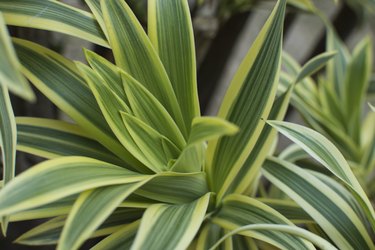
Corn plant (Dracaena fragrans), is usually grown as a foliage houseplant, although it also grows as a perennial in the warm climates of U.S. Department of Agriculture plant hardiness zones 10 through 12 in shady locations. Outdoors, this African native potentially grows 50 feet tall, but if you keep it in a pot indoors, it will stay around 4 to 6 feet tall. Corn plant grows easily with the right light, water, fertilizer and an occasional pest inspection.
Planting a Corn Plant
Video of the Day
An ideal spot for the cornstalk dracaena is one that's bright without being in direct sunlight, which can scorch leaves. Choose a pot that's just slightly bigger than the root ball, no more than one third larger. Fill the container with an indoor potting mix, and place the plant so the top of the root ball lies an inch below the container's top edge. Give the corn plant a thorough watering after planting it.
Video of the Day
Apply Fertilizer Seasonally
From spring through fall, a corn plant needs monthly feeding with a liquid fertilizer specifically for houseplants. Look for one that doesn't contain superphosphate. Mix 1/2 teaspoon of the fertilizer with 1 gallon of water, or according to the label rates.
Replace one regular watering each month with the fertilizer solution to avoid overwatering. Use enough of the solution to moisten the soil all the way to the bottom of the container until the excess starts to seep out the holes. Add plain water if the 1 gallon of fertilizer solution isn't enough to thoroughly wet the soil. If you over-fertilize, the plant will develop yellow or burned tips and leaf margins.
Watering Year-Round
Water your corn plant regularly in spring, summer and early fall. In late fall, allow the soil to dry slightly between waterings. In the winter, allow the water to warm up to room temperature before you use it.
Browning, dead-looking leaves mean either you're overwatering or underwatering. If the soil feels wet and muddy, let it dry out and make sure the container has holes in the bottom so water can drain. If the soil is dry and hard, water more frequently.
Winter Care
In the winter, keep your corn plant looking lush by spraying the leaves with room-temperature water. Misting the leaves increases humidity during dry weather or because of indoor heating. You can also set the container on a tray filled with pebbles and a little water in the bottom of the tray, below the pebbled surface. As the water evaporates around the corn plant, it adds humidity.
In summer, the corn plant can live outside, but in winter, keep it indoors in bright light where you can maintain daytime temperatures between 60 and 70 F and nighttime temperatures of 50 to 60 F. Plants grown in light conditions that are too bright can develop streaks and dry patches on the foliage. Foliage may drop when temperatures suddenly fluctuate or the corn plant is situated in a drafty area.
Pests and Pest Solutions
While generally resistant to most pests, you may find scale insects and spider mites bother your corn plant. Scale insects looks like hard lumps that dislodge when you press them with your fingernail. Spider mites are dark, minuscule pests that feed in colonies on the leaves. You'll often see a fine webbing over the leaves that looks like a spider web.
The least toxic way to get rid of these pests is simply by using a damp cloth to dislodge them. Avoid using insecticidal soap because this can damage dracaena plants.
Corn plants grown on soils that are constantly saturated in water can develop root rot. To prevent root rot, use correct watering practices and use an organically rich and well-draining potting mix. If grown outdoors in the ground, choose a spot with soil that drains well, and water only when the soil becomes dry.
Trimming and Size Maintenance
While a corn plant doesn't require pruning, you can trim the stalk to keep it from getting too big. Use a pair of sharp shears to cut it back to the height you want to maintain. This foliage plant will put out new leaves and grow more vigorously after pruning. Clean your pruning shears with rubbing alcohol before and after trimming plants.